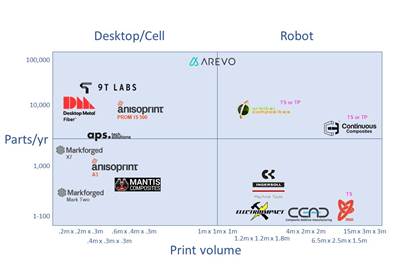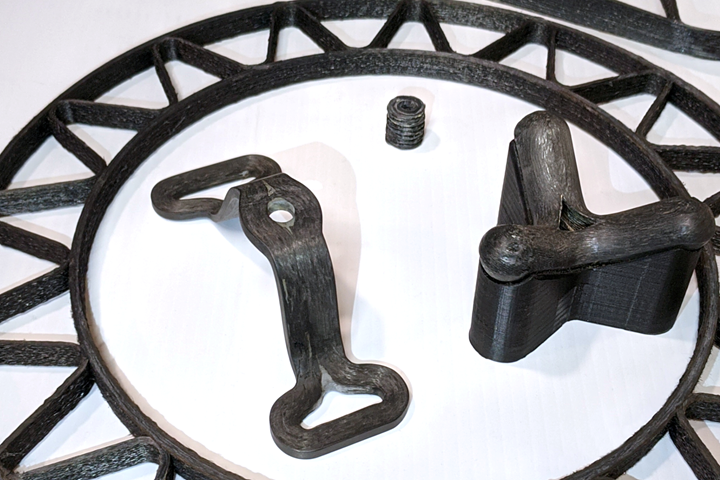
Mantis Composites developed its continuous fiber, fused filament fabrication (FFF) based 3D printing technology to provide the aerospace and defense industries with an option for small, complex, highly tailored, high-performance components for aircraft and other vehicles. Today, Mantis Composites continues pushing the envelope further with R&D in space components and ceramic matrix composites (CMC). Photo Credit, all images: Mantis Composites
According to Ryan Dunn, CEO of Mantis Composites (San Luis Obispo, Calif., U.S.), he and fellow co-founders David Zilar, COO, and Michael DeLay, CTO, recognized a gap in the composites market for producing highly detailed, high-performance aerospace and defense parts using lightweight carbon fiber composites.
“There is a lot of work being done in increasingly larger aerospace structures — aircraft fuselages, and that sort of thing — and even in 3D printing with large-format additive manufacturing, but we realized there was a need for smaller, highly intricate, even customized parts for engines, brackets or other areas that other composites companies weren’t taking on,” he says.
Dunn, Zilar and DeLay met while they were students at California Polytechnic State University, and combined their experience and education in composites, 3D printing and business to develop what would become their company’s custom-designed, five-axis, continuous fiber 3D printer — as well as a business plan and the industry connections needed to reach their goals.
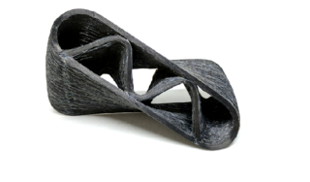
In addition to printing highly complex components, services offered include custom design/engineering, post-processing, bonding and surface treatment.
Mantis Composites was officially founded and moved into its own facility in 2014, and the team worked to optimize its technology for a few years before ramping up in 2017, Dunn explains. “When asked to measure ourselves, we like to say we’ve grown to 10 people and 24 robots,” he says.
Mantis Composites’ technology uses a fused filament fabrication (FFF) 3D printing system, which essentially entails extruding a filament made up of a pre-impregnated, continuous fiber/towpreg. The company also developed its own specialized design software to model and print parts with the accuracy needed to create detailed components to meet aerospace specifications. Parts can be printed on a range of commercial materials, though Dunn notes mostly carbon fiber and high-temperature thermoplastics like polyetheretherketone (PEEK) are used.
Today, operating three additive manufacturing (AM) cells with a maximum print volume of 18 x 20 inches, Mantis Composites offers custom design/engineering, printing, postprocessing, bonding and surface treatment services for each of its projects. Fiber placement accuracy is said to be within ±0.015 inch (±0.4 millimeter) tolerance, and lower after postprocessing such as machining or sanding.
Much of the company’s commercial and R&D work remains within the realm of relatively small, detailed, high-performance components for aerospace, defense or space applications, at volumes of up to several hundred of each part per year. “We specialize in ultra-high-temperature-capable carbon fiber thermoplastic composites with high fiber volumes,” Dunn explains. Parts are highly engineered for strength, stiffness and thermal capabilities, and completed projects include parts for aircraft landing gears, weapons mounting components, brackets and gearbox housings.
Case study: U.S. Air Force beam and bracket
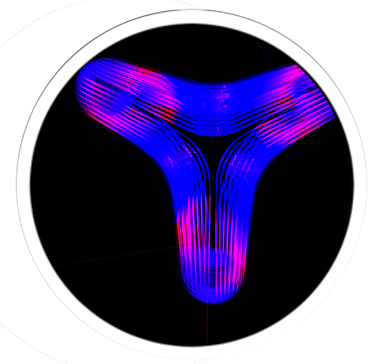
Specialized design software is used for accurate modeling and printing. This image shows the fiber path for printing a carbon fiber/PEEK bracket demonstrator for the U.S. Air Force.
Between 2018-2020, Mantis Composites worked with the U.S. Air Force (USAF, Washington, D.C., U.S.) on a demonstrator beam and bracket structure for use in an optical space telescope. The original structure comprised an Invar connector fitted to a tube-shaped truss structure. Funded by NASA’s Jet Propulsion Laboratory (JPL) as well as private sector customers, the project aimed to replace the Invar connector with an integrated composite assembly that reduced weight and exhibited a low CTE (coefficient of thermal expansion) more suitable for thermal environments in space.
Using continuous Hexcel (Stamford, Conn., U.S.) IM7 fiber and Solvay (Alpharetta, Ga., U.S.) PEEK, Mantis Composites printed the component, which was then bonded to a truss structure. “What we produced is a standardized, integrated product that is thermally optimized for space,” Dunn says.
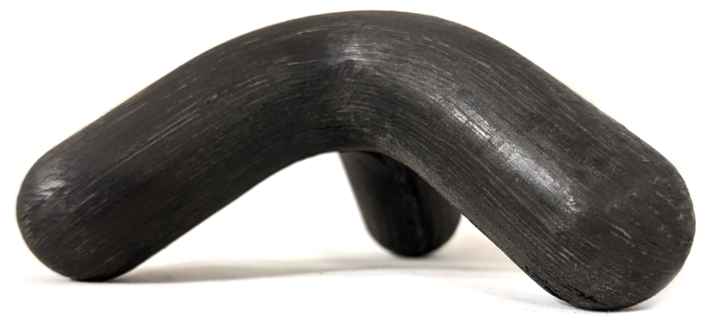
The final bracket is a hollow, tube-shaped structure that weighs a tenth of the original Invar part, with eight times lower thermal expansion.
One challenge to the project, however, was controlling the fiber direction, particularly in the printing of the hollow, tube-shaped part. Ultimately, the completed part was a similar shape to the original Invar part, at a tenth of the weight, with eight times lower thermal expansion.
Next steps? “Since then, we’ve been moving forward with very similar projects for customers, having demonstrated the capabilities,” Dunn says.
R&D and future efforts
Research and development focuses include continued optimization of the process, new bonding and integration techniques, and materials for extreme temperatures, such as carbon/carbon and silicon-carbide ceramic matrix composites (CMC).
Related Content
Low-cost, efficient CFRP anisogrid lattice structures
CIRA uses patented parallel winding, dry fiber, silicone tooling and resin infusion to cut labor for lightweight, heavily loaded space applications.
Read MoreFirst Airbus A350 crash confirmed in Haneda
Shortly after touch-down, a JAL A350-900 aircraft recently collided with a De Havilland Canada Dash 8. Exact circumstances are still unknown.
Read MoreOtto Aviation launches Phantom 3500 business jet with all-composite airframe from Leonardo
Promising 60% less fuel burn and 90% less emissions using SAF, the super-laminar flow design with windowless fuselage will be built using RTM in Florida facility with certification slated for 2030.
Read MoreDevelopment of a composite liquid hydrogen tank for commercial aircraft
Netherlands consortium advances cryogenic composites testing, tank designs and manufacturing including AFP, hybrid winding, welding of tank components and integrated SHM and H2 sensors for demonstrators in 2025.
Read MoreRead Next
3D printing with continuous fiber: A landscape
Growth continues in suppliers, part size, production volume and markets.
Read MoreScaling up, optimizing the flax fiber composite camper
Greenlander’s Sherpa RV cab, which is largely constructed from flax fiber/bio-epoxy sandwich panels, nears commercial production readiness and next-generation scale-up.
Read MoreNext-gen fan blades: Hybrid twin RTM, printed sensors, laser shock disassembly
MORPHO project demonstrates blade with 20% faster RTM cure cycle, uses AI-based monitoring for improved maintenance/life cycle management and proves laser shock disassembly for recycling.
Read More

.jpg;width=70;height=70;mode=crop)


















